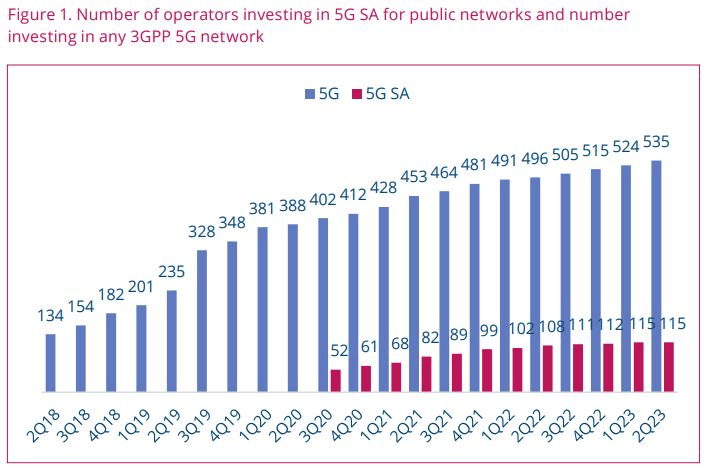Mobile networking technologies have seen substantial transformation recently, particularly with the adoption of 5G Standalone (5G SA). This aligns with the drive to generate new revenue streams from service categories that rely on guaranteed latency, speed and connection density to create value for a broad range of industry verticals. However, overseeing these new services and the underlying networks supporting them has become a more dynamic and intricate task. Network slicing, in the context of the coexistence of 5G and legacy wireless networks, adds yet another dimension of complexity for network and service operations (NOC/SOC) teams.
5G SA global investment snapshot:
As of July 2023, 115 operators in 52 countries and territories had invested in public 5G standalone networks, according to GSA data. This equates to 21.4% of the 535 operators known to be investing in 5G licenses, trials or deployments of any type.

Source: 5G-Standalone July 2023 Summary | GSA
While it is still relatively early days, it is evident that deploying 5G standalone is the preferred strategy for a growing number of operators. This shift entails an investment in ensuring services that only 5G SA can facilitate, particularly 5G network slicing.
Operators are increasingly testing and deploying 5G standalone networks. With a totally new, cloud-based, virtualized, microservices-based core infrastructure, 5G SA brings benefits including lower latency, support for massive numbers of devices, and programmable systems enabling faster and more-agile creation of services and network slicing. As the momentum behind 5G SA networks and devices continues, we can expect to see more operators deploying the new services they enable.
Joe Barrett, President, Global mobile Suppliers Association
What is 5G network slicing?
5G network slicing involves the dynamic allocation and activation of resources and network functions, spanning from the core to the access network. Its purpose is to meet the overall capacity requirements of services within a slice and its sub-slices at any given time, ensuring that Service Level Agreements (SLAs) between the service provider and the customer are consistently met.
It is important to note that 5G network slicing isn't just a standalone service; it's a catalyst for services. Operating multiple dedicated networks on a common platform, which is what network slicing allows, enables the provisioning of dedicated network resources tailored to various business customers. This paves the way for the creation of specialized services, each having unique needs in terms of latency, reliability, bandwidth, security, quality among other factors.
What are the benefits of 5G network slicing?
5G networks, in combination with network slicing, permit business customers to enjoy connectivity and data processing tailored to specific business requirements adhering to a SLA established with the mobile operator.
This emergence of SLA-backed enterprise services unveils new monetization opportunities for service providers. It is worth highlighting that when a network slice encompasses services vital to a business, tailored to its capacity and budget requirements, the potential for monetization encompasses the complete network slice including the Quality of Service (QoS) and Quality of Experience (QoE) associated with these services, which become equally valuable and marketable aspects.
All the above means that establishing a new watermark of ‘carrier-grade’ performance (reliability; speed; latency etc.) is becoming a cornerstone of the mobile network operator’s value proposition differentiation. However, this is no simple task as 5G network slicing presents multifaceted challenges.
What are the challenges of 5G network slicing?
Distinct service categories generate diverse peaks and troughs in usage, often with less predictability or cyclical patterns. These intricacies, both individually and collectively, create novel dynamics for network operators.
As such, network operators are faced with two new realities:
- Real-time visibility for SLA-backed services: Uninterrupted real-time visibility becomes a linchpin for harnessing fresh revenue streams from SLA-backed services. Without such insights spanning network domains and layers, operators cannot promptly detect and manage network conditions, thus minimizing or averting SLA breaches.
- Automation and frequency of updates: The evolution of slice creation and updates in the 5G landscape calls for heightened automation, rendering reliance on conventional manual procedures impractical. The efficacy of network slice orchestration, aimed at optimizing resource costs, will be a pivotal factor in driving incremental profit.
5 key requirements to successfully monetize 5G network slicing
Network slicing transcends the realms of voice, video, and data to embrace a diverse spectrum of customized services. These offerings, woven into a dynamic network configuration, will define the future. Yet, getting network slicing right in terms of customer experience and profitability remains paramount.
Some examples of services enabled by 5G network slicing include machine-to-machine/IoT, ultrareliable low latency slices, vehicle-to-everything and mobile broadband. Each will have its own combination of QoS and QoE requirements. Along with each involving innovative charging models that will add to 5G revenue. Meeting stringent, service-specific SLAs becomes imperative.
There are some key criteria which, therefore, must be front and center when it comes to assuring 5G network slices:
- Cloud-native scalability and flexibility: to support any new 5G services that are yet to be launched, with the ability to correlate everything and provide in real-time a feedback mechanism linked to the service, management and orchestration layer
- Multi-domain, multi-layer visibility: to monitor the end-to-end network slice and identify issues impacting the service delivery and SLAs, anywhere in the network
- Tailored QoE and QoS guarantees: for each use case and service, for example the required specific latency or throughput levels, reachability, availability, bandwidth and reliability, must be guaranteed through slice business insights and analytics
- Comprehensive analytics: operators need a single customizable and easy-to-understand view of all the multi-dimensional details of a 5G slice, including subscribers, devices, applications, services, down to the network resources and underlying infrastructure performance, with access to deep-dive reports per domain
- Intelligent and automated troubleshooting: Operators require comprehensive end-to-end troubleshooting capabilities across services, networks, and infrastructure. This includes automated anomaly detection, analysis, and resolution, resulting in faster mean time to repair and improved adherence to SLAs
Simplifying 5G network slicing monetization with Infovista’s 360º Assurance
To overcome the challenges of delivering 5G SLA guarantees, operators demand comprehensive visibility and control over network slices’ resource performance and customer experiences. This underpins service delivery based on business intent.
Infovista's 360° Assurance solution for 5G Slicing is powered by Ativa™, Infovista’s cloud-native suite for automated assurance and operations. Thanks to its pre-configured, cross-domain, and end-to-end capabilities, service providers can:
- Get correlated, real-time visibility of end-to-end 5G slice SLAs across radio access, transport, edge, and core networks
- Correlate SLA-impacting degradations to the underlying service, network and infrastructure problem for swift detection and resolution of customer-impacting issues
- Automate root-cause analysis, customer impact analysis, trouble-ticket creation and enrichment, as well as self-healing actions for proactive and streamlined troubleshooting
- Automate severity assignment and prioritization of issues based on business impact
- Rapidly initiate 5G slicing-enabled service delivery, mitigating the capability gaps present in legacy service assurance solutions
- Accelerate investment monetization while optimizing operational expenditure
In essence, 360° Assurance for 5G Slicing propels the realization of carrier-grade performance standards while optimizing revenue generation and operational efficiency.
The benefits of 360º assurance include:
- Supporting SLA guarantees across dynamic and programmable network topologies and interdependencies with 360º visibility and control of your infrastructure, network functions, services, and customers
- Assuring highly reliable connectivity and rapid reaction time to issues through real-time, AI/ML-driven slice predictive analytics and cross-domain troubleshooting
- Understanding what extra network capacity exists to create more slices, as well as the SLAs that can be supported across multiple concurrent services, through clear visualization of network slice management at scale
- Identifying severity of problems, prioritizing and resolving them based on impact on customers and the associated SLAs, ultimately mitigating the risk of SLA breaches
- Automating tasks and workflows for faster mean time to resolution, improved customer experience and higher SLA conformance
- Streamlining operations through a single source of truth across different teams in the organization resulting in TCO consolidation and OPEX optimization
- Accelerating time to market and service monetization with end-to-end slice SLA assurance and automation
- Future-proof cloud-native platform with support for multi-tenancy, CI/CD pipeline, predictive AI/ML modeling, closed-loop automation, and AIOps
More helpful pages:
- Datasheet: Ativa™ 360° Assurance for 5G Slicing Solution
- Whitepaper: How 360⁰ customer experience assurance will help to increase RoI










